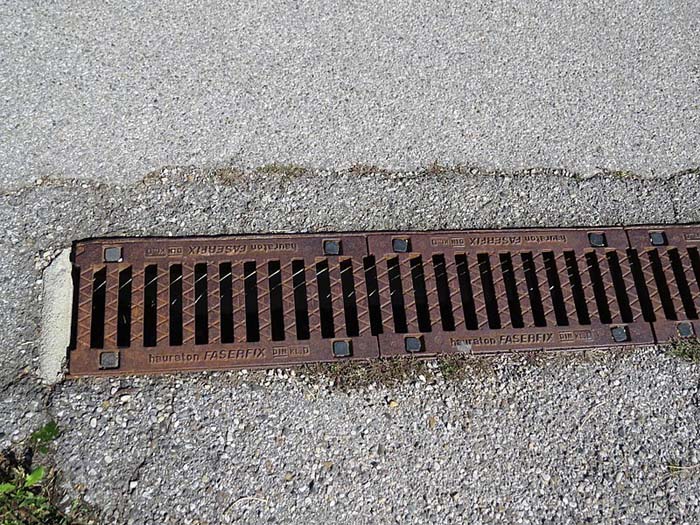
A channel drain is one drainage system that can be effectively used when managing surface water runoff. A long, narrow channel or trench collects and redirects water away from a flood—or pooling-prone area. The grate covering it is typically detachable. Parking lots, patios, driveways, and areas surrounding pools are just a few examples of the many industrial, commercial, and residential locations that frequently use these drains.
Channel drains are made to look good in addition to their practical use. Grates suitable for covering the channels are available in various materials and patterns to complement their natural setting, including metal, plastic, or composite. Because of their adaptability, channel drains can be built in various layouts to suit different site conditions.
Here are the main differences between a channel drain and a trench drain:
Channel Drain
- Installation
Channel drains’ prefabrication makes them more convenient to install. Modular parts are available to create various configurations.
- Materials
These drains are often made of stainless steel, polymer concrete, or plastic. They often have a detachable grate on top for easy maintenance and to keep dirt out.
- Use Cases
Patios, pool decks, driveways, and sidewalks are common areas for installing channel drains in commercial and residential areas to control surface runoff. They are also used frequently in some industrial settings.
- Design
A channel drain is a type of prefabricated water collection and conveyance system that is narrow and lengthy. It is often set up at or just below ground level and features a specified width and depth.
Some of the key benefits of channel drains are:
- Ease of maintenance
To keep them in good working order for as long as possible, most channel drains come with detachable grates that you can easily maintain and clean.
- Customizable designs
Channel drains serve an important drainage purpose while blending in with their surroundings, thanks to various grate colors, patterns, and materials.
- Safety enhancement
Reduced surface water runoff from channel drains makes wet surfaces less slippery, making them safer for vehicles and pedestrians.
- Effective water management
Channel drains decrease the likelihood of structural damage, erosion, and flooding by collecting and directing water into a collecting point or drainage system.
Channel drains are a dependable solution for surface water management and water collection problem prevention. They help make outdoor spaces safer and more durable.
Trench Drain
Trench drains, sometimes called line or channel drains, are drainage systems that gather and direct runoff from a surface. The standard design element is a long, narrow trench with a detachable cover or grate that directs water flow into the trench and eventually into a drainage system or another specified exit. Trench drains are widely used in a variety of contexts, including:

- Stadiums and Sports Fields
The goal is to ensure the fields and stands remain dry during the rain.
- Highways and Roads
It is important to drain water properly and avoid pools of water.
- Residential Areas
In order to avoid flooding, place them along pool decks, patios, and driveways.
- Industrial and Commercial Areas
Specifically, control water flows from wide areas like warehouses, loading docks, and parking lots.
Trench Drain
- Installation
Because trench drains are custom-built, concrete work, forming, and digging are often required for their construction.
- Materials
Due to their increased weight and traffic exposure, trench drains typically consist of concrete or other robust materials. They incorporate a detachable grate to enhance protection and simplify maintenance.
- Use Cases
Trench drains are typically preferred for larger-scale projects requiring better water flow control, such as industrial areas, parking lots, roads, and airport runways.
- Design:
People often use the term “trench drain” to describe an on-site, linear drainage system. In order to create the drainage channel, a lengthy trench is excavated into the earth and subsequently lined with concrete or another material.
Some major benefits of trench drains are as follows:
- Advantages for the Environment
Trench drains efficiently direct runoff, lessening the likelihood of soil erosion and water pollution. This helps create a healthier environment and fosters sustainable water management practices.
- Versatility
Trench drains can benefit many different types of surfaces. Some examples are industrial and commercial areas, patios, parking lots, pool decks, walkways, and driveways. Their adaptability makes them a go-to for a wide range of tasks.
- Customizability
Trench drains are modular, so they are adaptable in terms of depth, width, and length. This adaptability allows for the development of custom-made drainage systems to meet the specific needs of each project.
- Space Efficiency
Trench drains are narrow and linear, designed to collect water efficiently without taking up too much room. This would be a godsend in places where conventional drainage systems would be too cramped.
- Sturdiness and Longevity
Materials such as polymer, stainless steel, or concrete are commonly used to construct trench drains. This ensures their long-term durability and functionality, allowing them to withstand extreme weather and severe traffic.
- Decreased Accidental Risks
Trench drains make places with heavy foot traffic safer by directing surface water away from walkways and other potential hazards.
- Aesthetics
There are ways to make trench drains look like they don’t even exist. Because they are available in various finishes and styles, you can find one that works with your home’s decor or the surrounding scenery. Decorative tiles or grates can help to cover some trench drains, making them look cleaner and more beautiful.
- Low Maintenance
Trench drains require less maintenance than other types of drainage systems. Their design, which allows for easy cleaning and inspection, makes maintaining their efficiency over time easier.
- Effective water management
By collecting surface water efficiently, trench drains reduce the likelihood of pooling water, erosion, and flooding. This is particularly beneficial in areas experiencing heavy rainfall or directing water away from structures.
Key Differences between a Channel Drain and a Trench Drain
- Material and durability:
Industrial and high-traffic areas frequently use trench drains. For this reason, they are usually built to withstand heavier loads and be more durable. Although long-lasting, channel drains are only suitable for light to medium loads.
- Installation
Since they come prefabricated, channel drains are typically easier to install than trench drains, which need more building and customization.
- Scale and scope
Larger-scale industrial projects use trench drains more frequently, whereas smaller residential areas use channel drains.
Conclusion
Both systems aim to manage surface water efficiently. Your project’s anticipated load, scale, and preferred simplicity of installation are some of the factors that will determine whether you should choose a channel drain or a trench drain.
